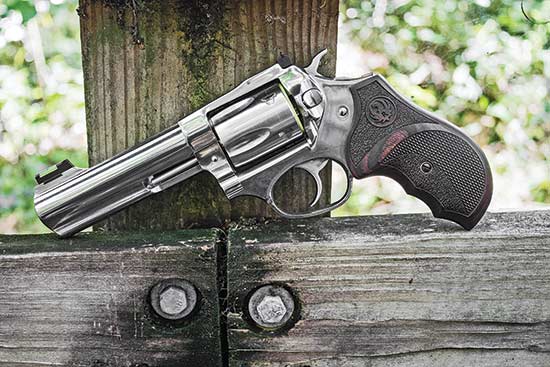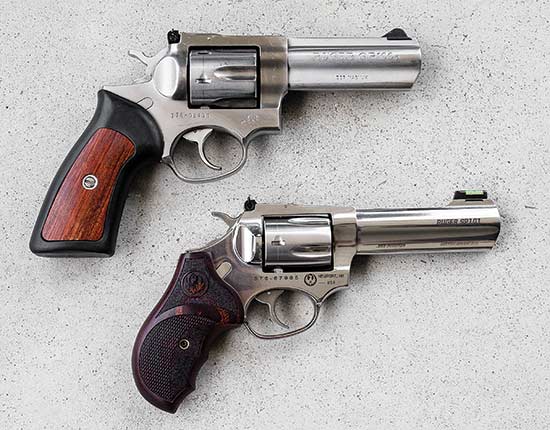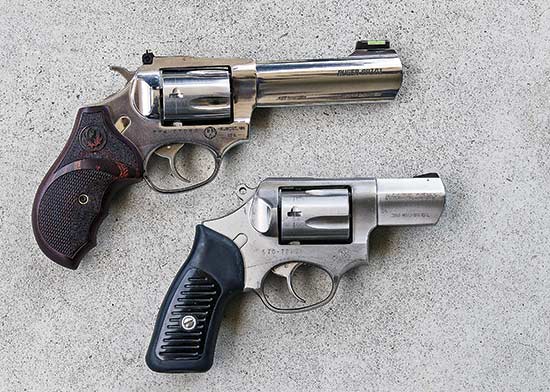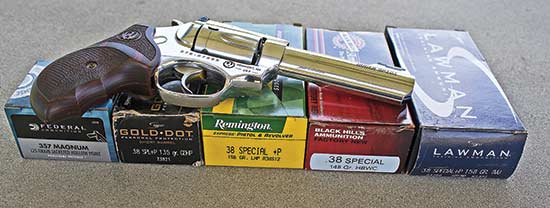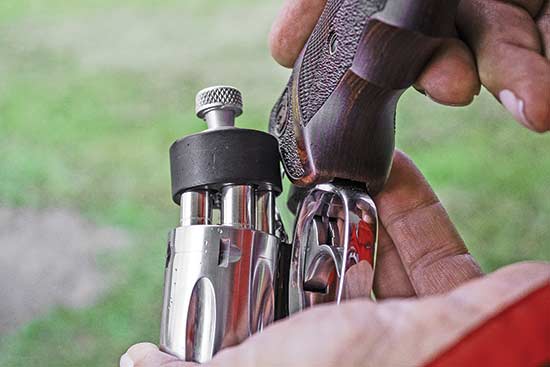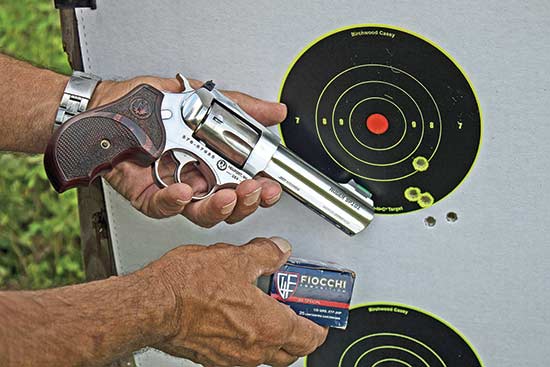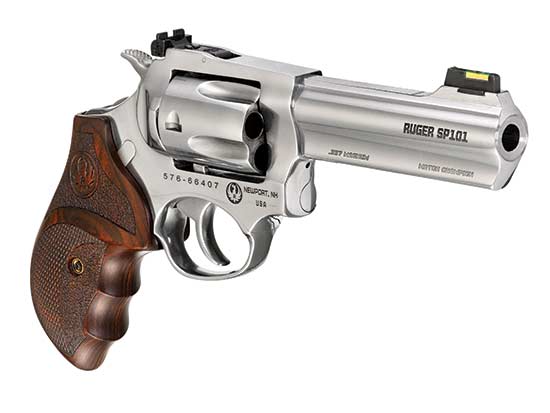Ruger's Perfect Packin' .357
Built just like, yup … a tank, the Ruger GP100 .357 Magnum has made a lot of friends over the decades. Just a few years ago Ruger came out with their Match Champion version. It had most of the barrel lug removed to lighten the front and help it track faster between multiple targets and its action seemed honed. And, it seemed logical to give the same Match Champion treatment to their smaller 5-shot SP101.
The SP101 was introduced in 1988, initially in .38 Special. In the spirit of total disclosure, I have to admit it’s a personal favorite of mine, and I even have some ego invested in it. I was the one who convinced Bill Ruger to make it in .357 Magnum.
A police department with which I’m well acquainted adopted the SP101 .357 in spur-less hammer DAO form more than 20 years ago. They issued one to each officer for off-duty and backup use. Used in qualification multiple times a year with .357 Magnum or .38 Special +Ps, not one of those guns has yet had to be replaced or even repaired.
SP101 Shootout
On this smaller .357, Ruger kept the full-length underbarrel lug, giving this little gun a good, steady “hang.” The company learned from its mistake with fixed sights on the first iteration of the GP100 MC. This one comes with an adjustable rear to take advantage of the wide .38/.357 range of ammo options and is combined with a green fiber-optic front sight. The Altamont hardwood stocks are handsomely cut and stained to resemble cocobolo. Capacity, of course, is still five rounds. Weight is a middle-of-the-road 30 oz.
We tested the SP101 MC with a half-dozen factory loads ranging from mild to wild. Protocol involved a Matrix rest on a concrete bench at 25 yards. We fired 5-shot groups measured to the nearest .05” — twice. Once for all five and again for the best three. The first measurement offers a good prediction of what a solid shooter can deliver when not under pressure. The second generally comes very close to what all five will do from a machine rest.
Black Hills’ .38 Special 148-gr. mid-range wadcutter is famous for its accuracy, and many believe it’s the best self-defense load for the recoil-sensitive. The little Match Champion put five of these 3.45″ apart, with the best three in a more promising 1.3″.
Two 158-gr. .38 Special +P loads were also tested. One was the lead semi-wadcutter HP famous for getting the .38 up off its knees in terms of “stopping power,” and was so widely adopted in its day it became known as the Chicago load in the Midwest, the Metro load in Florida and the FBI load everywhere else. Ours was the Remington brand, which — historically — has expanded the best.
While celebrated for its potency, this load was never famous for accuracy. We were reminded why when it delivered a horrible 8.7″ group with one round so far to the right I figured it had to be my fault, so I gave the gun a mulligan and fired a sixth shot, which went to the same distant spot. At least the best three were in 2.15″!
The other 158-gr. +P, however, was Speer’s Lawman FMJ training load, with which I won several state and regional IDPA Stock Service Revolver championships back when a high-power factor was required. The Lawman proved much more compatible with the SP101 and plunked five shots into 2.65″ with the best three into 1.85″.
The 125-gr. JHP is popular as a .38 Special self-defense load, and was represented here with Fiocchi’s standard-pressure offering, using the consistently accurate Hornady XTP bullet. Accuracy was the “Best of Test” in every respect, with a 5-shot group measuring 1.90″ and the best three going into an even 1″.
The “in” load for short-barreled revolvers these days is the 135-gr. Speer Gold Dot +P bonded JHP. ATK’s Ernest Durham designed it expressly for the 2″ backup guns of the NYPD. It has worked wonderfully from there to the West Coast ever since, and seems to work well in the dwindling numbers of 4″ revolvers old cops were still grandfathered to carry in the Big Apple. The 5-shot group went 3.35″ with the best three into 1.30″.
For a .357 Magnum round we used that fabled man-stopper, Federal’s 125-gr. semi-JHP, rated at 1,450 fps from a 4″ barrel. It grouped a bit lower than the .38 loads and delivered a 5-shot 3.55″ group running 3.55″ vertically by 1.80″ wide. The best three made a tidy 1.15″ group.
Sights, Stocks & Function
There’s more to accuracy than precise grouping. There’s also how close the shot comes to the sight picture — the point of aim/point of impact. The SP101 MC came out of the box okay for elevation, but hitting some 7.5” inches right of the POA at 25 yards. Fortunately it comes with adjustable sights, and we gradually tracked the gun to center, though once it got there the rear-sight leaf had been moved far to the left.
The finger-grooved Altamont stocks are a bird’s head shape and are nicely checkered, with the Ruger logo in the wood instead of in a medallion. They’re a bit narrow toward the back, and while less than fun with magnum recoil, weren’t as uncomfortable as I thought they’d be. Their rakish angle seems to reduce muzzle rise.
Our test gun’s chambers were on the rough side and we had to pound spent casings out at first, even those of low-pressure .38 wadcutters. This eased up some once we had a few hundred rounds through the little beast. Alas, there was another problem on the other end of the ejection stroke. The left panel of the Altamont stocks blocked even relatively short .38 Special casings from clearing completely, making it a pain in the butt to open the path for the next reload. And the same too-thick grip panel blocked the HKS speedloader — tilting it far enough sideways to make it extremely difficult to get the loader to release its cartridges.
Having been spoiled by customized double-action revolvers, I found this one’s DA pull on the heavy, but consistent side at 11.5 lbs. as measured on a Lyman digital scale from Brownells. However, the DA stroke was very even and smooth. In single action the break was clean at 4.75 lbs. with little backlash.
Searching for a Niche
This little revolver begs a big question: What kind of match is it likely to be champion of? It got a lot of ballyhoo at its introduction as the “Ultimate Back-Up Gun.” Unfortunately, its 4.2″ barrel is way too long for any BUG match I’ve ever heard of. Nor will it qualify for Service Revolver in either of those games because each requires a 6-shooter and the SP101’s cylinder is a round short. The 5-round sequences would be fine for a bull’s-eye match, but 6″ barrels are preferred for that. You want more sight radius for International Handgun Metallic Silhouette Association or NRA Hunter Pistols as well.
The Ruger folks have become aware of this. Vice President Mark Gurney told me, “You’ve managed to hone in on the one possible flaw in the gun — the name. I believe in its size it would not likely be used in a match, as it would be up against 6-round capacity guns. However we chose to keep the name consistent with the very well-received GP100 Match Champion as the SP received the same treatment in a factory action job with centering shims, nice grip and visible sights.”
I agree with Mark. I see the SP101 Match Champion more as an outdoorsman’s SP101 “Kit”-type gun. A sturdy, relatively light revolver for the outdoorsman who’s using it as backup to a long gun and who wants more than .22 power.
This gun’s configuration would also be ideally suited to the new gun owner who wants a home-defense handgun that could be carried concealed if necessary.
Bottom Line
I liked the SP101 Match Champion as a fun gun and outdoor companion revolver. I liked the fact once we got the sights dialed in, everyone who shot it stayed tight in the 10-ring at seven yards. At this distance I was able to double-action four into one ragged hole with the fifth shot just next to it.
As someone who has shot and owned Rugers since age 11, I was disappointed by the rough chambers and ejection problems. The grip situation? Mark Gurney had this to say:
“We modified the Altamonts to clear the speedloaders. Apparently the gun you have didn’t get the memo.” I believe that. Our test sample was one of the first to leave the factory. But the rough chambers and the sights being as far off of POA/POI as they were for a revolver with an $859 price tag just wasn’t right.
I also brought all this to Mark’s attention. Ruger zealously guards their company’s hard-earned reputation for being at the top of the heap in terms of responsiveness to customer complaints so he quickly sent another sample SP101 MC. This one shot to the sights out of the box. Extraction was smooth, easy and uneventful.
This gives me reason to expect that by the time you read this, the problems we encountered with our early-production test gun have been squared away. But we wanted to be honest, so we reported what we got. But then again, it’s often the case with very early “pre-production” guns. But our testing often influences changes to production guns. While on the one hand makers are anxious to get samples into our hands, they also stand by to make changes as needed based on what we discover. It’s a process that works fine.
The SP101 Match Champion concept, despite the identity crisis in its name, is a very desirable recreational revolver.
Ruger
Ph: (336) 949-5200
[email protected]
